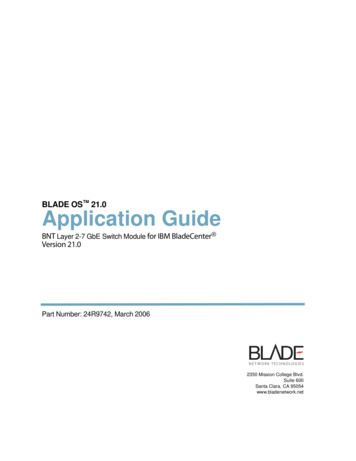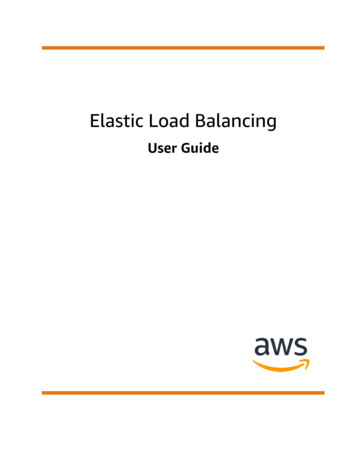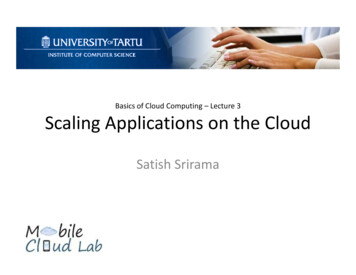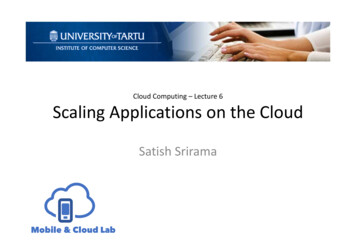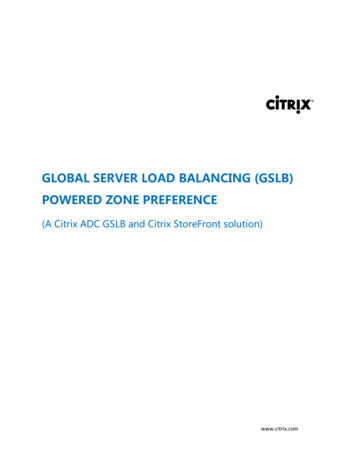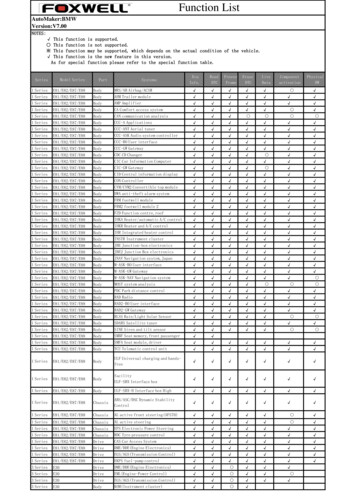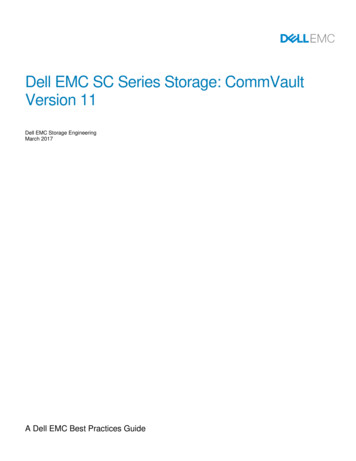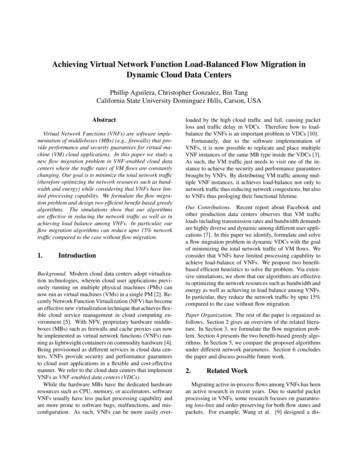
Transcription
Achieving Virtual Network Function Load-Balanced Flow Migration inDynamic Cloud Data CentersPhillip Aguilera, Christopher Gonzalez, Bin TangCalifornia State University Dominguez Hills, Carson, USAAbstractVirtual Network Functions (VNFs) are software implementation of middleboxes (MBs) (e.g., firewalls) that provide performance and security guarantees for virtual machine (VM) cloud applications. In this paper we study anew flow migration problem in VNF-enabled cloud datacenters where the traffic rates of VM flows are constantlychanging. Our goal is to minimize the total network traffic(therefore optimizing the network resources such as bandwidth and energy) while considering that VNFs have limited processing capability. We formulate the flow migration problem and design two efficient benefit-based greedyalgorithms. The simulations show that our algorithmsare effective in reducing the network traffic as well as inachieving load balance among VNFs. In particular, ourflow migration algorithms can reduce upto 15% networktraffic compared to the case without flow migration.1.IntroductionBackground. Modern cloud data centers adopt virtualization technologies, wherein cloud user applications previously running on multiple physical machines (PMs) cannow run as virtual machines (VMs) in a single PM [2]. Recently Network Function Virtualization (NFV) has becomean effective new virtualization technique that achieves flexible cloud service management in cloud computing environment [5]. With NFV, proprietary hardware middleboxes (MBs) such as firewalls and cache proxies can nowbe implemented as virtual network functions (VNFs) running as lightweight containers on commodity hardware [4].Being provisioned as different services in cloud data centers, VNFs provide security and performance guaranteesto cloud user applications in a flexible and cost-effectivemanner. We refer to the cloud data centers that implementVNFs as VNF-enabled data centers (VDCs).While the hardware MBs have the dedicated hardwareresources such as CPU, memory, or accelerators, softwareVNFs usually have less packet processing capability andare more prone to software bugs, malfunctions, and misconfiguration. As such, VNFs can be more easily over-loaded by the high cloud traffic and fail, causing packetloss and traffic delay in VDCs. Therefore how to loadbalance the VNFs is an important problem in VDCs [10].Fortunately, due to the software implementation ofVNFs, it is now possible to replicate and place multipleVNF instances of the same MB type inside the VDCs [3].As such, the VM traffic just needs to visit one of the instance to achieve the security and performance guaranteesbrought by VNFs. By distributing VM traffic among multiple VNF instances, it achieves load-balance not only tonetwork traffic thus reducing network congestions, but alsoto VNFs thus prologing their functional lifetime.Our Contributions. Recent report about Facebook andother production data centers observes that VM trafficloads including transmission rates and bandwidth demandsare highly diverse and dynamic among different user applications [7]. In this paper we identify, formulate and solvea flow migration problem in dynamic VDCs with the goalof minimizing the total network traffic of VM flows. Weconsider that VNFs have limited processing capability toachieve load-balance of VNFs. We propose two benefitbased efficient heuristics to solve the problem. Via extensive simulations, we show that our algorithms are effectivein optimizing the network resources such as bandwidth andenergy as well as achieving in load balance among VNFs.In particular, they reduce the network traffic by upto 15%compared to the case without flow migration.Paper Organization. The rest of the paper is organized asfollows. Section 2 gives an overview of the related literature. In Section 3, we formulate the flow migration problem. Section 4 presents the two benefit-based greedy algorithms. In Section 5, we compare the proposed algorithmsunder different network parameters. Section 6 concludesthe paper and discuss possible future work.2.Related WorkMigrating active in-process flows among VNFs has beenan active research in recent years. Due to stateful packetprocessing in VNFs, some research focuses on guaranteeing loss-free and order-preserving for both flow states andpackets. For example, Wang et al. [9] designed a dis-
tributed flow migration framework to decouple the statetransfer and packets migrations, which allows optimizingthe two processes separately and in parallel. Another issueis VNF elasticity control, which studies how to scale out,scale in, and load balance VNFs depending on the trafficload. Sun et al. [8] built a flow migration controller toachieve VNF elasticity control by selecting flows for migrations based upon buffer overflow avoidance and migration cost calculation, with the goal of minimizing the loadvariance of VNF instances. Qazi et al. [6] proposed to minimize the maximum load of a VNF in order to achieve VNFload-balancing. They show that the problem is NP-hard,thus the optimal load-balancing VNF is time-consumingto compute in a large scale VDCs.In contrast to all above work, we achieve load-balancingof VNFs by specifying that each VNF has a limited processing capacity. Instead of minimizing the maximum loador the load variance of VNF instances, our goal is to migrate the flows to minimize their total communication costwhile respecting the capacity constraint of VNFs.Our previous work [1] proposed a VNF load-balancingmechanism called LB-MAP. Its goal is to assign VM flowsto VNFs to minimize the communication cost of all theVM flows while taking into account of the limited processing capacity of the VNF. However, LB-MAP not only assumes that all VM flows have the same traffic rates but alsoassumes the traffic rates of VM flows do not change overtime. Therefore it fails to consider the dynamic and diversecloud traffic that commonly exists in cloud data centers.Consequently the algorithms proposed in LB-MAP do notwork well for dynamic traffic scenario in cloud data centers. Moreover, instead of considering that all VNFs havethe same capacities as in LB-MAP, we consider that different VNFs could have different processing capacities thustargeting a more general scenario.3.Problem FormulationSystem Model. We model a VDC as an undirected general graph G(V, E). V Vp Vs includes a set of PMsVp and a set of switches Vs , and E is the set of edges.There are l communicating VM flows F {q1 , q2 , ., ql },where flow qi (vi , vi0 ) consists of two VMs vi and vi0 thatcommunicate with each other with some traffic rates. Suchrates could be communication frequencies or bandwidthdemands of this flow. Let V {v1 , v10 , v2 , v20 , ., vl , vl0 },and VM v V is located at PM s(v) Vp .Traffic Model. In a dynamic network traffic scenario, thetraffic rates of VM flows are constantly changing. Letλi denote the traffic rates of qi at some moment and λ hλ1 , λ2 , ., λl i the traffic rate vector of the l VMflows at this moment. In Fig. 1, there are two VM flows:q1 (v1 , v10 ) and q2 (v2 , v20 ) with initial traffic rates λ h100, 1i. As the VM traffic rates change over time in a dynamic VDC, λ changes constantly. In Example ?later, we will show that how dynamic traffic increases thecommunication costs of VM flows dramatically and howmigrating flows from one VNF to another can mitigate thedynamic traffic in a VDC.VNF Model.There are m VNF instances M {vnf1 , vnf2 , ., vnfm } of the same VNF type (i.e., firewalls, load balancers, etc.) in the VDC. We leave the workof traversing multiple VNF types in some order (i.e., service function chains) as future work. We assume that eachswitch is attached with a server that can install VNFs [11]and all the m VNFs are installed on servers on differentswitches. Let’s assume that vnfj is installed on switchw(j) Vs and w(j) 6 w(j 0 ) if j 6 j 0 . For security andperformance purposes, each communicating VM flow qimust traverse one of the VNF instances. Let’s assume thecapacity of vnfj , 1 j m, is κj , meaning it can process atPmost κj VM flows at the same time. Obviously wemhave j 1 κj l; otherwise it cannot find a valid VNFassignment for the VM flows. In Fig. 1, there are two VNFinstances: vnf1 and vnf2 with κj 1, j 1, 2. Table 1shows all the notations.NotationVpVsFλi λMs(v)w(j)κjc(u, v)ci,jµCcpCcffCmCtfTable 1. Notation SummaryExplanationThe set of PMs in an VDCThe set of switches in an VDCThe set of l VM flows, qi (vi , vi0 )Traffic rate of qi , 1 i l λ hλ1 , λ2 , ., λl i is the traffic rate vectorThe set of m VNF instances, vnfjThe PM where VM v is locatedThe switch where vnfj is installedThe processing capacity of vnfjThe cost between any two nodes u and vThe communication cost of qi with vnfjThe flow migration coefficientThe total comm. cost of all VM pairs atinitial VNF assignment pThe total comm. cost after flow migration fThe total flow migr. cost under migration ffThe total cost Ctf Cm CcfCost Model. Each edge (u, v) E has a cost indicating either the delay or energy cost on this edge caused byone unit of VM communication or flow migration. Givenany PM or switch u and v, let c(u, v) denote the total costof all the edges traversed by VM communication or flowmigration from u to v. Thus the communicationcost of any VM flow qi is λi · c s(vi ), s(vi0 ) and the flow migration cost of migrating any VM flow from vnfi to vnfj
: VMvnf1vnf1vnf2vnf1vnf2vnf2: PM: VNFinstancev1’ v1 v2’ v2123456789(a)10 11 12 13 14 15 16v1’ v1 v2’ v2v1’ v1 v2’ v212345678910 11 12 13 14 15 1612345(b)678910 11 12 13 14 15 16(c)Figure 1. A fat tree-based VDC with 16 PMs. There are two VM flows: (v1 , v10 ) and (v2 , v20 ) with initial traffic ratevector h100, 1i, and two VNF instances: vnf1 and vnf2 , with capacity κj 1. (a) The initial VNF assignment is (v1 , v10 )traverses vnf1 following blue dark line while (v2 , v20 ) traverses vnf2 following red light line, resulting in minimum totalcost of 100 4 1 8 408. (b) Due to dynamic traffic, the traffic rate vector becomes h1, 100i. The resultant VMcommunication cost becomes 1 4 100 8 804, a dramatic increase. (c) By migrating (v1 , v10 ) to vnf2 and (v2 , v20 )to vnf1 , it reduces to 1 8 100 4 408. Total flow migration cost is 10 2 20 assuming µ 10. So total cost ofVM migration and communication is 408 20 428, a 46.8% decrease compared to the cost before flow migration. is µ · c w(i), w(j) . Here µ is flow migration coefficient,which is the ratio between costs of VM flow migration andVM communication. For example, it could represent therelative size of memory or data packet transferred in VMflow migration and communication. Let ci,j be the communication cost for VM flow qi when it traversesvnfj ; 0ci,j λi · c s(vi ), w(j) c w(j), s(vi ) .Let p : [1, 2, ., l] [1, 2, ., m] denote the initial VNFassignment, indicating that qi F is currently traversing vnfp(i) M while the capacity constraints of VNFsare satisfied: {1 i l p(i) j} κj , 1 j m. The communicationcost of qi with p is then ci,p(i) λi · c s(vi ), w(p(i)) c w(p(i)), s(vi0 ) .ThePtotal communicationcost of all the l VM flows islCcp i 1 λi · c s(vi ), w(p(i)) c w(p(i)), s(vi0 ) .Note that given the m VNF instances and the l VMflows of different traffic rates, how to assign flows toVNF instances to minimize Ccp while satisfying the capacity constraints of VNFs has been solved optimally in[1]. However, in a dynamic VDC, as the traffic rate vec tor λ changes, the Ccp computed in [1] is no longer optimal. In Fig. 1, with initial traffic rate vector h100, 1i,the optimal VNF assignment is that (v1 , v10 ) traverses vnf1following dark blue line while (v2 , v20 ) traverses vnf2 following light red line, resulting in minimum total cost of100 4 1 8 408. Next, due to dynamic traffic, thetraffic rate vector changes to h1, 100i. The resultant VMcommunication cost becomes 1 4 100 8 804, adramatic and an almost 100% increase.Problem Formulation. Therefore there is a need to migrate the VM flows from one VNF instance to another inorder to reduce the network traffic while still satisfying thecapacity constraints of VNFs. As migrating flows incursnetwork traffic and cost, we need to find an optimal flowmigration scheme to minimize the total VM flow migrationand communication cost. We define a flow migration function as f : [1, 2., .l] [1, 2, ., m], meaning that the flowqi will be migrated from its current VNF vnfp(i) to VNFvnff (i) . f (i) p(i) means the flow of (vi , vi0 ) does not Plfmigrate. Let Cm µ · i 1 c p(i), f (i) be the total migration cost of all the l VM flows with flow migration f .Let Ccf be the total communication cost of all VM flowsafter VM flow migration f . Let Ctf be the total cost ofVM flow migration and communication after flow migra Plf Ccf µ · i 1 c p(i),f (i) tion f . Then, Ctf Cm Pl0. The obi 1 c s(vi ), w(p(i)) c w(p(i)), s(vi )jective is to find a flow migration f such that Ctf is minimized under the processing capacity constraint of VNFs: {1 i l f (i) j} κj , 1 j m.Consider the example in Fig. 1 with the new traffic ratesh1, 100i. Now if we migrate (v1 , v10 ) to vnf2 and (v2 , v20 )to vnf1 , the total communication cost reduces to 1 8 100 4 408. The total flow migration cost is 10 2 20 assuming µ 10. So total VM flow migration andcommunication cost is 408 20 428, a 46.8% decreasescompared to the cost before flow migration.4.Algorithm SolutionsDefinition 1: (Benefit of Flow Migration.) Given aVDC graph G(V, E) and flow assignment p(i), indicating that VM flow qi traverses VNF vnfp(i) . The benefit ofmigrating qi from vnfp(i) to another VNF vnfj , denotedas B ji , is the total cost reduction resulted from this flowmigration; B ji ci,p(i) ci,j µ · c(w(p(i)), w(j)).Benefit-based Algorithm 1. Algorithm 1 works as follows.
First, we sort all the VM flows in the non-ascending order of their traffic rates. Then we start with the one withhighest traffic rate and migrate it to a VNF that gives thelargest benefit without violating this VNF’s capacity. Thiscontinues until all the VM flows are migrated. Finding theminimum communication cost between of all flows takeO(l · V 2 · log V ). Migrating VM flows to VNF instancestakes O(l · m), where m is bounded by V . Therefore thetime complexity is O(l · V 2 · log V ).Algorithm 1: Benefit-based Algorithm 1.Input: A VDC G(V, E) with l VM flows and m VNFsOutput: Flow migration scheme f (i), indicating that qi ismigrated from vnfp(i) to VNF vnff (i) , and the resultedtotal communication and flow migration cost Ctf .Notations:i: the index for VM flowsj: the index for VNF instancesp(i): (vi , vi0 )’s initial assigned VNF vnfp(i)f (i): (vi , vi0 ) migrates to VNF vnff (i)loadj : the current load of vnfj , initially 0B i : the largest benefit of migrating qi , initially 1. Compute Ccp , the total communication cost under initialVNF assignment p(i);2. Sort all VM flows in the non-ascending order of theirtraffic rates. Assume λ1 λ1 , ., λl WLOG;3. for (i 1 to l)4.B i ;5.for (j 1 to m)6.if (loadj κj )7.B ji ci,p(i) ci,j µ · c(w(p(i)), w(j));8.if (B ji B i )9.B i B ji , f (i) j;10.end if;11.end if;12.end for;13.Ccp Ccp B i ;14.loadf (i) ;15. end for;16. Ctf Ccp ;17. RETURN {f (1), f (2), .f (m)} and Ctf .Benefit-based Algorithm 2. In this algorithm, for VNF instance vnfj , we migrate κj VM flows to vnfj that havenot been migrated such that those migrations give the topκj maximum benefits when traversing vnfj . The runningtime again is O(l · V 2 · log V ).Algorithm 2: Benefit-based Algorithm 2.Input: A VDC G(V, E) with l VM flows and m VNFsOutput: Flow migration scheme f (i).Notations:i: the index for VM flowsj: the index for middlebox instancesp(i): (vi , vi0 )’s initial assigned VNF 8.19.5.f (i): (vi , vi0 ) migrates to VNF vnff (i)F j : the set of VM flows migrated to vnfjmigratedi : true if qi has already migrated,false if not; initially falseCompute Ccp , the total communication cost under initialVNF assignment p(i);for (j 1 to m)F j φ;for (i 1 to l)if (migratedi f alse)B ji ci,p(i) ci,j µ · c(w(p(i)), w(j));F j { i, B ji } F j ;end if;end for;Sort F j in the non-ascending order of B ji ;F j {(x1 , B jx1 ), (x2 , B jx2 ), .}, where B jx1 B jx2 .;for (k 1 to κj )Ccp Ccp B jxk ;f (xk ) j;migratedxk true;end for;end for;Ctf Ccp ;RETURN {f (1), f (2), .f (m)} and Ctf .Performance EvaluationSimulation Setting. We investigate the performance of thetwo benefit-based algorithms viz. Algorithms 1 and 2,which are referred as Benefit1 and Benefit2, respectively.We compare them with the case without any flow migration, which is referred to as NoMigration. We create a fattree VDC with k 8 of 128 PMs, where k is the numberof ports each switch has. The VMs are randomly placedon the PMs and the VNF instances are randomly placed onthe switches. In all the simulation plots, each data point isan average of 10 runs, and the error bars indicate 95% ofconfidence interval. For fair comparison, we run the algorithms on the same VDC with the same VM flow and VNFinstance placement for each simulation run. In each case,we set the VNF capacity κj d ml e.Varying Number of VM Flows l. Fig. 2 varies the number of VM flows l from 100, 200, ., to 900 while fixingthe number of VNF instances m as 5 and the migrationcoefficient µ as 100. It shows that the total costs of Benefit1 and Benefit2 are smaller than that of NoMigration,demonstrating that VM flow migration is an effective technique to reduce network traffic. Comparing Benefit1 andBenefit2, as Benefit1 migrates VM flows with high trafficrates first, the resulted benefits of such migrations are generally higher than those obtained in Benefit2, which resultsin lower total cost for Benefit1.
cloud data centers. In the future, we will do more simulations to validate our algorithms and check if there exists anoptimal and efficient flow migration algorithm.Total Cost64 103.5 1063 10662.5 1062 101.5 1061 tThis work was supported by NSF Grant CNS-1911191.References[1]100 300 500 700 900Number of VM PairsFigure 2. Varying number of VM flows l. m 5 andµ 100.3 106Total Cost2.5 10NoMigrationBenefit2Benefit162 1061.5 1061 10650000001510Number of VNFsFigure 3. Varying number of VNF intances m. l 500and µ 100.Varying Number of VNF Instances m. Fig. 3 varies thenumber of VNF instances as 1, 5, 10 while fixing the number of VM flows l as 500 and µ as 100. When m 1,all three yield the same cost as all the VM flows must gothrough the same and only VNF. With the increase of m,we observe that Benefit1 and Benefit 2 both perform betterthan NoMigration. In particular, Benefit1 reduces the totalcost by up to 10-15%. This again demonstrates that ourflow migration problems are valid and our flow migrationalgorithms are effective.6.M. Alqarni, A. Ing, and B. Tang. Lb-map: Load-balancedmiddlebox assignment in policy-driven data centers. InProc. of IEEE ICCCN 2017.[2] M. Armbrust, A. Fox, R. Griffith, A. Joseph, R. Katz,A. Konwinski, G. Lee, D. Patterson, A. Rabkin, I. Stoica,and M. Zaharia. A view of cloud computing. Commun.ACM, 53(4):50–58, 2010.[3] A. Jukan F. Carpio, S. Dhahri. Vnf placement with replication for load balancing in nfv networks. In Proc. of IEEEICC 2017.[4] R. J. Martins, C. B. Both, J. A. Wickboldt, and L. Z.Granville. Virtual network functions migration cost: fromidentification to prediction. Computer Networks, 181(9),2020.[5] R. Mijumbi, J. Serrat, J. L. Gorricho, N. Bouten, F. D.Turck, and R. Boutaba. Network function virtualization:State-of-the-art and research challenges. IEEE Communications Sur. and Tut., 18(1), 2015.[6] Z. A. Qazi, C.-C. Tu, L. Chiang, R. Miao, V. Sekar, andM. Yu. Simplefying middlebox policy enforcement usingsdn. In Proc. of ACM SIGCOMM 2013.[7] A. Roy, H. Zeng, J. Bagga, G. Porter, and A. C. Snoeren.Inside the social network’s (datacenter) network. In Proc.of SIGCOMM 2015.[8] C. Sun, J. Bi, Z. Meng, T. Yang, X. Zhang, and H. Hu.Enabling nfv elasticity control with optimized flow migration. IEEE Journal on Selected Areas in Communications,36(10):2288–2303, 2018.[9] Y. Wang, G. Xie, Z. Li, P. He, and K. Salamatian. Transparent flow migration for nfv. In Proc. of the ICNP, 2016.[10] C. You and L. M. Li. Efficient load balancing for the vnfdeployment with placement constraints. In Proc. of IEEEICC, pages 1–6, 2019.[11] Y. Zhang, N. Beheshti, L. Beliveau, G. Lefebvre,R. Manghirmalani, R. Mishra, R. Patney, M. Shirazipour,R. Subrahmaniam, C. Truchan, and M. Tatipamula. Steering: A software-defined networking for inline servicechaining. In Proc. of IEEE ICNP 2013.Conclusion and Future WorkAddress for correspondence:We have studied how to migrate VM flows in VNFenabled cloud data centers to reduce the dynamic traffic while load-balancing VNFs. Our goal is to optimizecloud network resources such as bandwidth and energyconsumption. We proposed two efficient flow migrationalgorithms. Our simulation results show that flow migration is an effective technique to reduce dynamic traffic inPhillip AguileraComputer Science DepartmentCalifornia State University Dominguez HillsCarson, California 90747paguilera5@toromail.csudh.edu
Here is flow migration coefficient, which is the ratio between costs of VM flow migration and VM communication. For example, it could represent the relative size of memory or data packet transferred in VM flow migration and communication. Let c i;j be the com-munication cost for VM flow q i when it traverses vnf j; c i;j i c s(v i);w (j .
